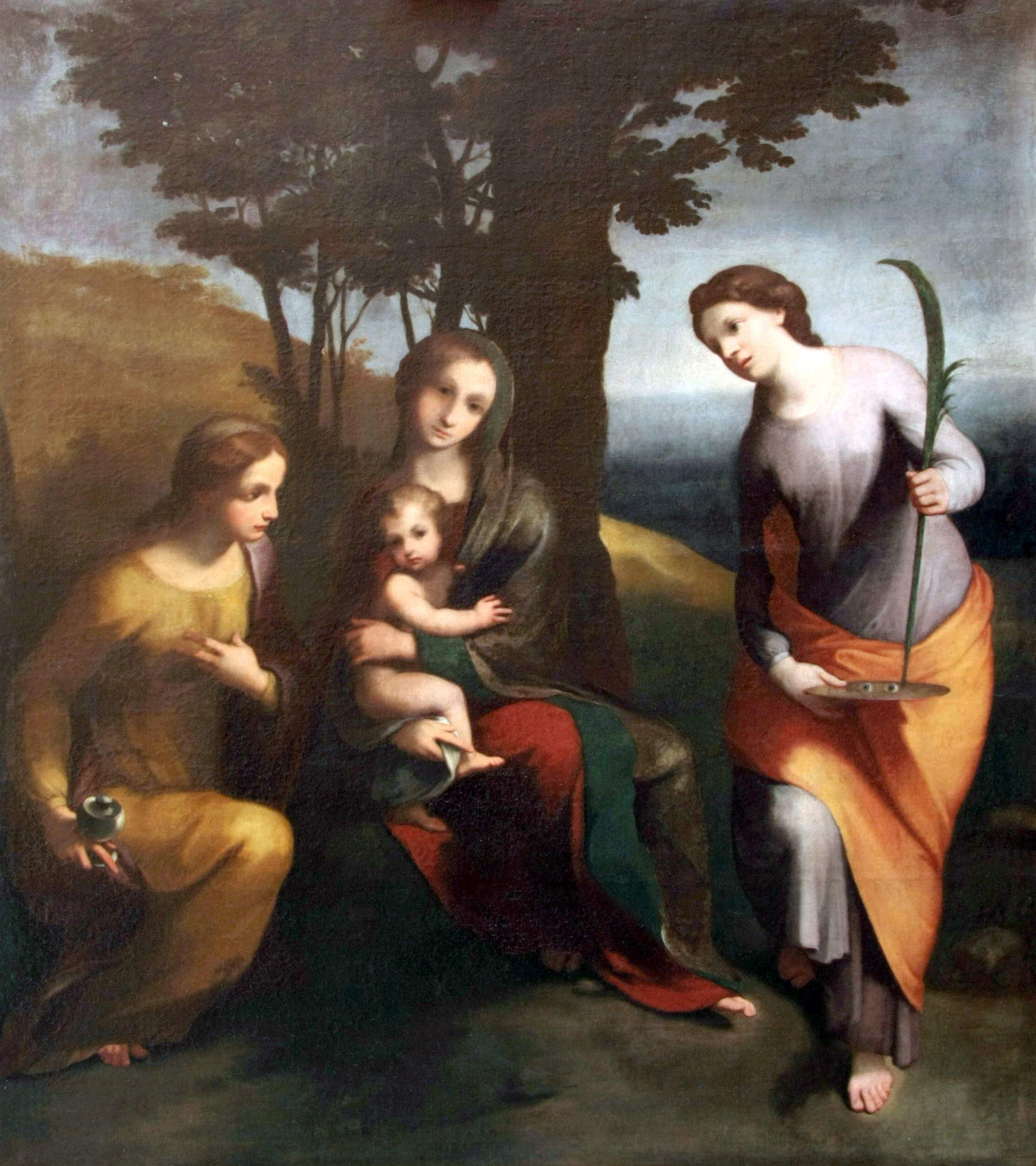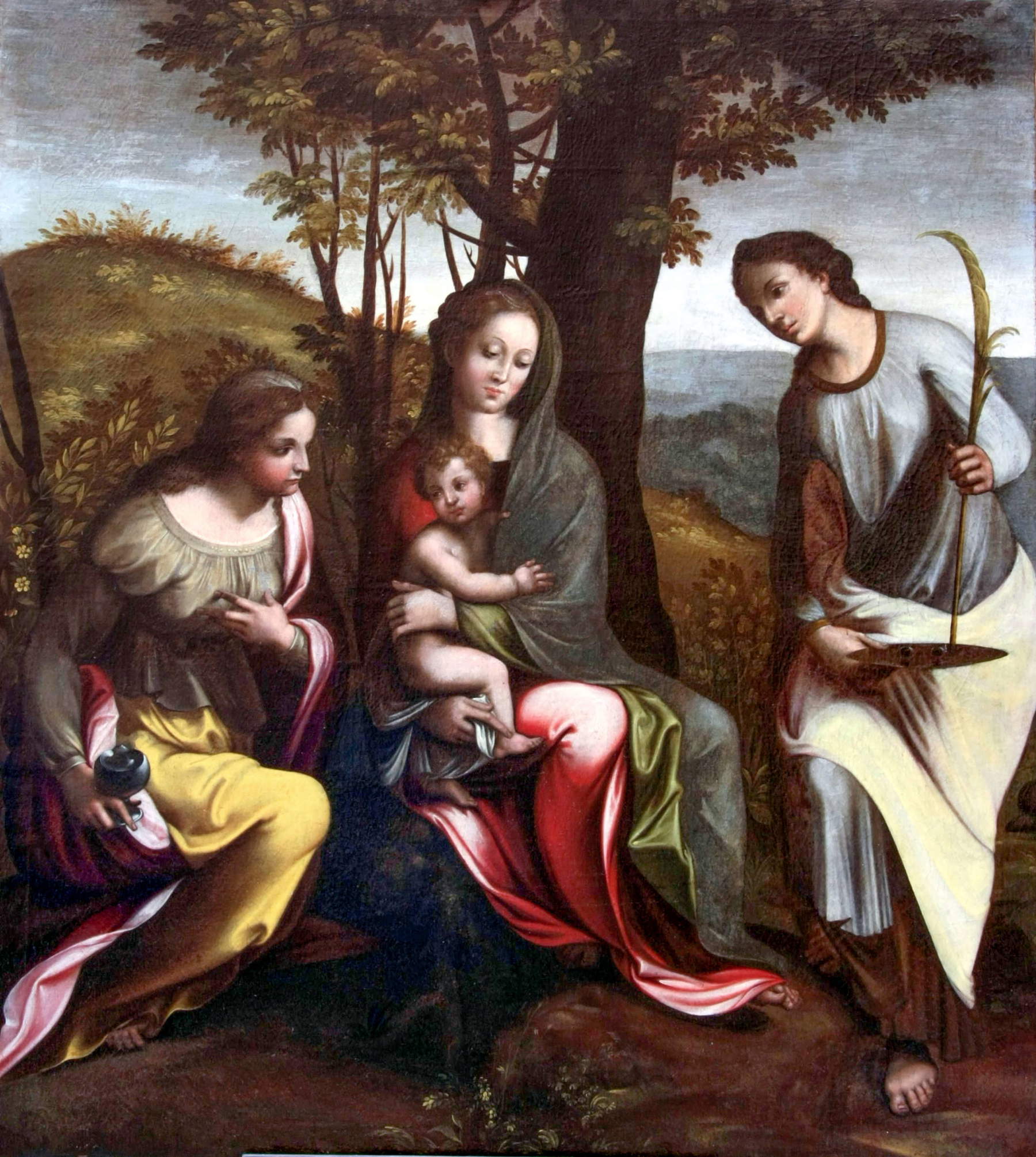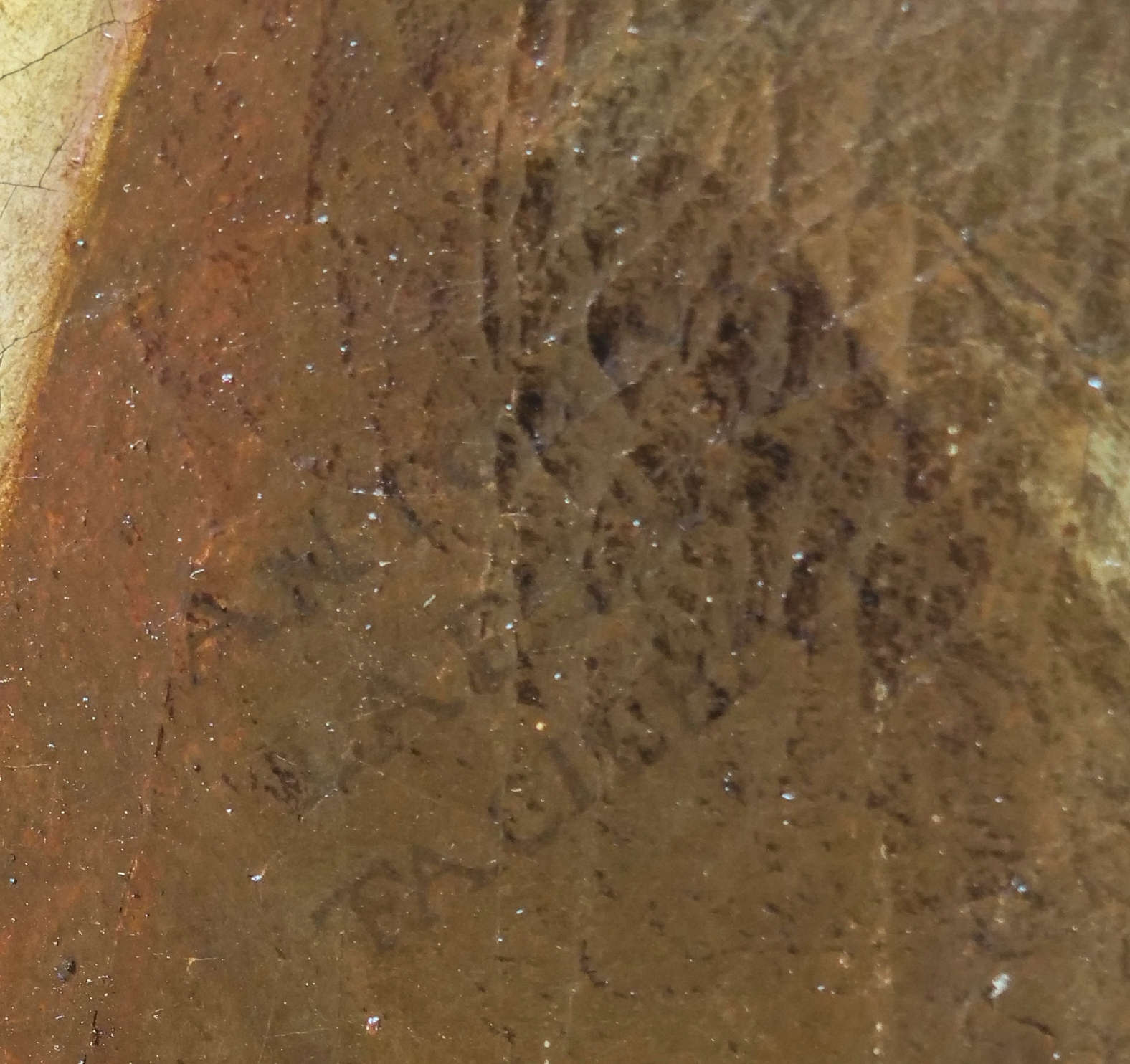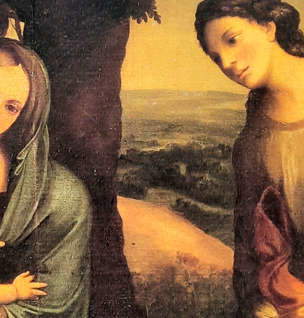The Madonna of Albinea, painted by Correggio in 1519, stands as a singular compositional and executive pivot at a temporal juncture of the height of the Italian Renaissance; that artistic phenomenon that had already reached the “great manner” and that saw the creative impetuses proposed by the celebrated masters oscillating at that time. Leonardo died on this same date, Raphael knew the last year of his activity, and Michelangelo withdrew into himself after the crisis at the tomb of Julius II.
The ranks of Italian painters were becoming disoriented from classical models, and the symptoms of Mannerism were now evident. The much-frequented theme of the Altarpiece knew considerable oscillations. At the crossroads of ancient patterns and new formal evidence, Correggio entered with his own language and high ethical-formal preparation. The most important precedent was Raphael’s"Sistine Madonna,“ which Allegri knew well having accompanied it from Rome to Piacenza with the learned Abbot Gregorio Cortese. From this he takes the concise outline of the ”three figures plus the Child" but rejects their cloudy suspension and in particular the great celestial distance of the Madonna, subtracted even from perspective foreshortening.

Correggio, always most human in his choices, for the parish church of Albinea pictorially arranges the Madonna in humility on the precise site of the sanctuary, above a meadow that slopes rapidly toward us, between the hills and the plain, and in this way makes every believer share in the immediacy of veneration and impetration of graces: here is the spiritual colloquy, necessary for every soul! The gentle centripetal rotation of the two saints gently accompanies our approach to Mary and Jesus. Mary Magdalene hands the ointment of the Resurrection and St. Lucy bears witness to love even to martyrdom: the complete femininity surrounding the Divine Child also makes this altarpiece a touching and most hopeful invitation.
Correggio thus overcomes the now blocked problem of the static co-presence of the saints, and initiates those new and authentic “sacred conversations” that would increasingly demand, with joy and spiritual enthusiasm, the participation of the faithful. Here was his most vivid contribution to the renewal of sacred art; a contribution that did not escape the notice of the most acute commentator on Correggio’s creative parabola, Cecil Gould, who pointed out in his time the extraordinary humanistic and tactile fusion of the figures with the landscape.
The events that affected the painting in earlier times have also recently been the subject of lengthy studies that have become the content of numerous publications to which we refer the interested reader. Here we will summarily limit ourselves to recalling that in 1638 the Duke of Modena, Francesco I, in order to remit an old debt of the Community of Albinea to the Ducal Chamber, demanded that the precious painting be delivered to him. Despite the firm opposition of the parish priest Don Claudio Ghidini, the painting was taken by the men of Albinea to Modena, and in its place the duke had a copy made by a French painter placed in the church, just as he had done a few months earlier with the Rest on the Flight into Egypt from the church of San Francesco in Correggio1.
Ten years later, in 1659, the new duke of Modena, Alfonso IV, who was very young and ill with gout and tuberculosis, was incumbent on the one hand to revere the new emperor, Leopold I-also very young-on the other hand to obtain the investiture of the principality of Correggio. He therefore ordered an embassy to Vienna led by Marquis Giovan Battista Montecuccoli. Among the various tributes for Archduke Leopold Wilhelm, the emperor’s uncle and a great fan of Correggio’s paintings, the Madonna of Albinea was almost certainly included. The painting, however, arrived in the capital ruined. In fact, during the long journey the pictorial film was eroded by the rubbing of the crosspieces of the case in which it was contained. Apparently, this was due to the oscillating movement of the crate itself as it was transported on the bars of the carts pulled by mules. The Archduke nevertheless accepted the work as it was, but never included it in his prestigious gallery. Thereafter, it is not clear what happened to our painting. “Hoarded” in some room of the imperial palace, it was perhaps irretrievably lost in a raging fire that destroyed an entire wing of the sumptuous palace in 1668.
In our parish church in the hills of Reggio remained the copy that we still see today and which tradition has it that it is by Boulanger, although other hypotheses are still open, since the duke had used other painters for the copies placed in the various churches he looted2. There also remains the possibility that this copy, believed by some to be sixteenth-century, may have been made in 1557, when the original was placed in safety in the oratory of San Rocco in Reggio to save it from the dangers of the ongoing war between the Farnese and the Este family, which involved the complete destruction of the parish church of Albinea. It is known, in fact, that several copies were made during that time3. In the sacristy of the Pieve, moreover, there is a copy of smaller dimensions than the original. And this is what we want to talk about.
To date, no documentary evidence concerning the making of this painting has been traced. In the inventories we do not find mention of it until 1613, but we know well that the scanty and sparse inventories of that period, both written by parish priests and those written during bishop’s visits, are inaccurate and often lacunose. It should also be remembered that the church was totally destroyed during the war between the Farnese and the Estensi in 1557 and that its reconstruction, as well as the resumption of normal functionality, took many years. It is only after the Council of Trent, in the visit of Bishop Rangone on September 23, 1613, that it appears, for the first time clearly enough, the presence in the Pieve di Albinea, in addition to the original, of a “copy” of the same painting by Correggio. In the inventory, in fact, are simultaneously recorded and described at the Altar Maggiore "Icona in qua picta est imago B. Maria e S. Magdalenae et S. Luciae opera Corrigii, " and at the altar of Our Lady a "Copia illius Corrigii. " By comparing the aforementioned visitation with the later ones, it can be guessed that the altar of the Blessed Virgin Mary was located in the right aisle, basically in the altar of the Manfredi4. Years later, with the renovation of the altar, the “small” copy was relegated to the Sacristy, to make way for Lippi’s large altarpiece, dated 1598 depicting the Madonna della Ghiara between Saints Prospero andBiagio5.


This painting, now in the sacristy, is signed “Antonius Laetus Faciebat. ”6 A detail of no small importance and still unknown by many. The pictorial signature, almost invisible to the naked eye, is placed at the bottom, on the right, above a stone7. For the sake of honesty, it must be said that we learned of the signature’s existence only during the 1981 restoration work carried out by the qualified Zamboni and Melloni studio, of Reggio Emilia, which specializes in the restoration of Allegri’s works8. The signature is very similar to the one that appears in identical position on the copy now preserved in Parma, which many scholars consider the closest to the original.
In fact, comparison of the signature with original works by Correggio can only be made with the Madonna of St. Francis (1515), now in Dresden, the first by Correggio to be signed, where, however, we find the inscription ANTO[N]IUS DE ALEGRIS P, and with the portrait of Veronica Gàmbara where we can hardly read ANTON LAETUS. But by 1519, after four years, the artist had had more extensive contact with humanists and with the courtly signatures of other painters (Raphael had already become Sanzius and Titian Vecellius), and he liked to cheerfully Latinize his own surname.9 Even the portrait of Veronica, executed between 1520 and 1521, is initialed with “ANT. LAET.” [Antonius Laetus). Then, in some contracts on paper, Antonius will sign himself Leto. Everything is explained when Allegri fully enters the intense humanistic and Renaissance mentality.

This painting poignantly preserves the intensity and precision of Correggio’s original. We can call it a “masterpiece” in relation to its replica or proof status. The definition stems from the compositional strength and resonant coloring: one can feel an original creative act in it. It can be observed that Mary’s eyes are lowered to look at her Little Son, as is a constant custom in Correggio’s Mothers; one can also note the admirable execution of Mary’s face and the softness of the flesh, which here is particularly captured in the small arm that Jesus extends toward the Mother’s heart.
What is more, there are Correggio’s “secret signatures” that are important for their meanings and for the careful arrangement of the composition. The first is that the two diagonals of the canvas intentionally meet over the heart of the Madonna: Correggio was most attentive to this almost secret effect and its value. The second consists in the fact that each of the three large figures stands within a well-defined third of the vertical space: this, too, is a secret rhythm that the eye does not specify at a mere glance but actually holds the composition harmoniously. The third “secret signature” is found in the horizontal-vertical division that composes a precise checkerboard of nine squares, and here the painter places the Baby Jesus, alone, within the central square! Let us not forget that Jesus is the Word of God and that His complete nudity signifies the sacrificial offering of His Body for the Redemption of all humanity: thus a Body that is placed in the absolute center of the painting. The geometric research was studied by Renza Bolognesi.

So we ask: why does the sacristy painting present us with a face that is different from both the sixteenth-century copies and also from the seventeenth-century one by Boulanger? Can we assume that the sacristy painting-though smaller in size than the others-is not a copy but an “other original”? Indeed, if it were also a mere copy of the original then the copyist, as the others had done, would have replicated exactly what he saw and what the patron undoubtedly demanded. The mystery would be explained if we accept the hypothesis that this might be that replica requested by the parish priest four years later from Correggio to be placed lower in a side altar more convenient to prayer, to please the faithful who complained that they could not admire up close the precious large image, kept customarily covered, toward which they were increasing their veneration?10Correggio no longer having the original that was in the church at hand, busy on the Parma frescoes, in order to satisfy the parish priest’s requests, may have painted only the Madonna’s marvelous face or little more, then leaving it to others to finish the work in detail. It would then be justified that the painter could have painted a Madonna similar but not the same as the previous altarpiece.
Could it instead be the preparatory sketch for the altarpiece made in Albinea by Correggio? The latter is not such an absurd hypothesis. In fact, the parish priest would never have agreed to move from the Pieve that miraculous tablet hanging in a side altar continually visited by the faithful as a dispenser of graces. According to the agreement, Allegri was supposed to come himself to Albinea and here, in the church, draw before the sacred image the necessary cues to then transfer it to a larger altarpiece. The same is true of the landscape in the background, in which, at least in the copy preserved in Parma, the reality seen from the church looking toward the plain seems recognizable. If we look closely at the Rome copy (rather than the Parma copy) in the glimpse of the landscape between the Madonna and Santa Lucia we also seem to recognize a hill with a tower house. This could be the “ben posta torre” that Ludovico Ariosto nostalgically recalls in his Rime, thinking back to the happy days when he stayed in Montejatico di Albinea ("Non mi si pon dalla memoria torre/ le vigne e i solchi del fecondo Jaco/ la valle e il colle e la ben posta torre" Satira IV, 124/126).
One might venture that Allegri, in the spring of 1517, after summarily making the sketch in Albinea, shown and liked by the commissioning parish priest, took it to his workshop in Correggio where, two years later, he made the altarpiece influenced by Leonardo’s work that he had seen in Milan at that very time.
Be that as it may, the Sagrestia canvas, though smaller in size than the original, is the earliest example of the Albinea Madonna that we can consider today. This painting poignantly preserves the intensity and precision of Correggio’s original. We can call it a “masterpiece” in relation to its state of being. The definition arises from the compositional strength and resonant coloring: one can feel an original creative act in it. It can be repeated here that Mary’s eyes are lowered to look at her Little Son, as is a constant custom in Correggio’s Mothers; we can also note the admirable execution of Mary’s face and the softness of the flesh that is particularly captured in the small arm that Jesus extends toward the Mother’s heart.


Giuseppe Menozzi (1897-1969), a painter, pupil first of Cirillo Manicardi then of Camillo Verno, teacher and restorer, for years considered one of the leading local art experts (a real talent in recognizing works of art and spotting forgeries and counterfeits)11, in the pages of Stampa Sera of November 19, 1938 claimed to have discovered in the sacristy of the Pieve di Albinea "a painting that, hitherto overlooked, would be an authentic masterpiece by Allegri. We are dealing with a painting of considerable artistic value and distinguished workmanship. Smaller in size than the one in the choir, and, fortunately, in an excellent state of preservation, it is immediately striking for its unparalleled expression. From a careful observation of the painting we were able to make those remarks that seemed useful to communicate.
The canvas is with white imprimitura: the whole painting is set, underneath, in chiaroscuro to black and with the shadows in brown, as Correggio was wont to do, which he then finished, with a half impasto of color in the highlights and colored glazes in the shadows.
The workmanship is bold and nervous, of one who creates, not of one who copies. It is sure, unrepentant. In addition to the flesh and drapery, there is a stunning mastery there, both in the foliage of the plants and in the grasses on the ground. We are undoubtedly dealing with a painting of supreme importance."
The critical-attributive problem remains open on the various sides: diagnostic, historical and attributive. As such we offer it for publication, well pleased that the Albinea Community and the art world can approach this valuable cultural asset.
1 Ligabue 2008, pp. 63-72 and 108; Ligabue 2009, pp.1-6; Cadoppi 2008, pp. 15-66.
2 On this see Sirocchi 2018, pp.125-128.
3 Of these, one is preserved at the Pinacoteca Capitolina in Rome and another at the Pinacoteca Nazionale in Parma. Both, at the bottom, above a stone, are signed ANTONIUS LAETUS FACIEBAT.
4 Bishop Coccapani’s 1625 visitation of the side altar mentions "imago B.V. que imitatur picturam Corrigii pictoris eccellentissimi" (Saccani1925, p.62). Cf. A. Cadoppi, BSR no. 147, April 2013, p.33.
5 Gabriele Lippi, Madonna della Ghiara fra i santi Prospero e Biagio, 1598, Pieve di Albinea, Manfredi altar. At the bottom, on the right, is the following inscription: “For Signora Cecilia Manfredi, the year of the lord 1598 Gabriele Lippi made.” It is the first painting made after the miracle of the Madonna of Reggio and is also the only work currently known of this Reggio painter.
6 Many scholars in the past denied that the work was signed. Most recently A. Cadoppi, BSR, no. 147, April 2013, p. 33.
7 That stone is not there casually. Correggio chose with particular care the places where he would put his signature (M. Spagnolo, Correggio, La Madonna di San Francesco, Silvana Milano 2015, p.110).
8 The Soprintendenza had already entrusted the restoration of many of Correggio’s works to this Studio in full confidence.
9 G.Adani, La Madonna di San Francesco, Silvana Ed., Milan 2015, p. 47.
10 Cfr.G. Saccani, La Storia di un capolavoro, in Strenna Pio Ist. Artigianelli, Reggio Emilia 1925, pp. 61-62.
Warning: the translation into English of the original Italian article was created using automatic tools. We undertake to review all articles, but we do not guarantee the total absence of inaccuracies in the translation due to the program. You can find the original by clicking on the ITA button. If you find any mistake,please contact us.